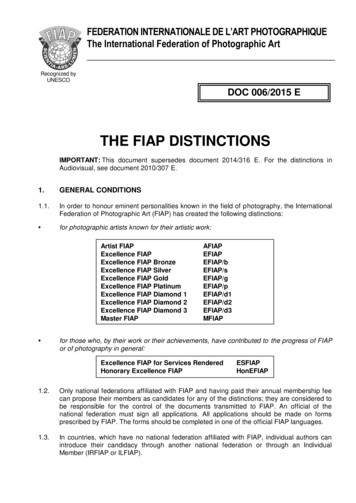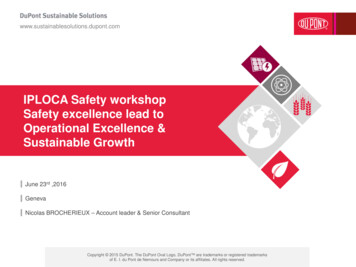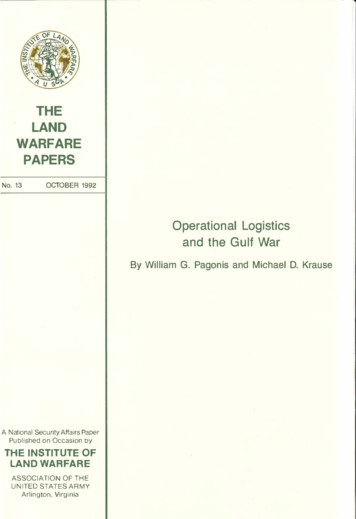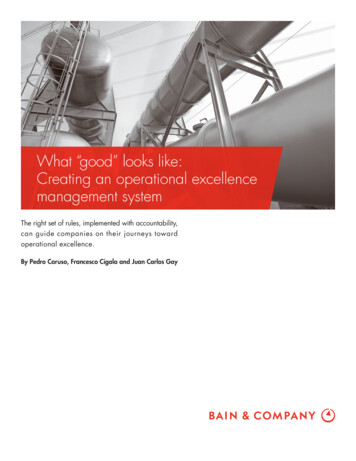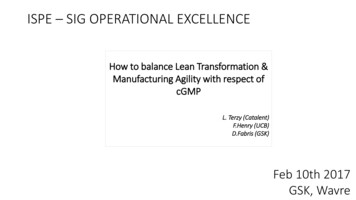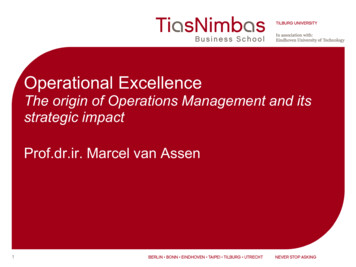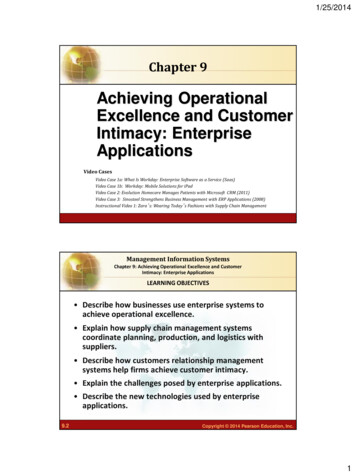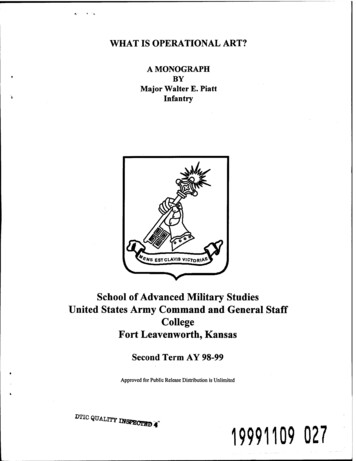
Transcription
Operational excellence–networked capabilities inaerospace and defense
Operational excellence–networkedcapabilities in aerospace and defenseMany aerospace & defense (A&D) companies are under intense pressure to deliver stronger financial performance.This pressure is manifesting itself in increased cost scrutiny, greater execution expectations, and increased customerdeliveries and service levels. The margin for error is thin with increasing competition often from non-traditionalsources. Both defense and commercial A&D manufacturers, regardless of their position in the supply chain, arebalancing greater production expectations with cost reduction mandates. This is a razor-thin line and over-indexingto either de-risk ramp-up complexities or reduce cost can drive failure for any A&D company.Our experience shows that the key to success in this challenging environment is the interface across internaloperating functions. And, with over 70% of the cost of the average program tied to the supply chain, this successoften also involves robust alignment with supply partners.Typical Interface Management ufacturingFunctional capabilities grow overtime, as improvement effortsoptimize functional performanceGaps between functions remainor even grow, making handoffsand improvements major points offailure and limiting performanceSupply ChainFunctional gaps compound as A&Dcompanies rely more on supplychain for cost/delivery performanceOperational Excellence Gaps (Examples) Part expedited at great cost only to sit on a shelf unused Capacity constraints due to supplier quality performance based on originalengineering design for producibility Shop-floor manufacturing performance improved but high inventory/partshortages persist due to misalignment with planningValue - In the form of cost, marginsand production performance is lostUnfortunately, over time, many companies have developed capabilities and expertise that reinforce thesefunctional silos. For example, some companies have a high-performing procurement function and high-performingengineering function but are less mature in aligning engineering and procurement objectives (e.g. Design forCost). This lack of alignment can be compounded by a management culture and performance metrics that, as thefunctions excel, make managing the interface increasingly difficult. Functional excellence with weak interfaces canactually destroy value in the form of cost, margin, working capital and production performance.Companies are striving for better ways to manage cross-functional performance to achieve operational excellence.Looking at this challenge through a different lens, we have defined a set of seven capability areas that lay thefoundation for operational excellence. Some of these could be within a functional organization and others areshared across functions.2
Operational Excellence Capabilities:1. Product Development and EngineeringLean EngineeringValue EngineeringDesign for X2. Manufacturing and Supply Chain StrategyCapability/FootprintMake/Buy and Should-CostTotal Cost ManagementIntegrated Supplier QualityQuality Assessment System3. Advanced Quality ManagementAPQ/DFQ4. Planning, Forecasting, and SchedulingS&OP/DIOPMaster/Prod. SchedulingWorking Capital Management5. Procurement and Spend ManagementStrategic SourcingTransactional PurchasingSupplier Collaboration/ManagementEfficiency/UtilizationRisk ManagementDeployment/Network Model3PL/Warehouse Ops6. Internal Operations and ProductionSynchronization7. Logistics, Distribution and AftermarketTransportationEach of these seven capability areas has multiple individual capabilities. And each of these individual capabilities canbe managed and optimized to excellence. But effectively managing an individual capability can reinforce isolationof a function and, sometimes, preclude company-wide operational excellence.Often optimizing an individual capability can negatively impact another. Consequently, most companies areproficient at managing adjacent capabilities shown horizontally in the diagram. These horizontal capability areasare loosely grouped by organizational function and are therefore typically easier to manage and measure.Operational excellence: networked capabilities in aerospace & defense3
Functional capability optimization: Procurement improvement as an t improvement as an example1. ProductDevelopmentand EngineeringLean EngineeringValue EngineeringDesign for X2. Manufacturing and Supply Chain StrategyCapability/FootprintMake/Buy and Should-CostTotal Cost ManagementIntegrated Supplier QualityQuality Assessment System3. Advanced Quality ManagementAPQ/DFQ4. Planning, Forecasting, and SchedulingS&OP/DIOPMaster/Prod. SchedulingWorking Capital Management5. Procurement and Spend ManagementStrategic SourcingTransactional PurchasingSupplier Collaboration/ManagementEfficiency/UtilizationRisk ManagementDeployment/Network Model3PL/Warehouse Ops6. Internal Operations and ProductionSynchronization7. Logistics, Distribution and AftermarketTransportationCompanies facing both production increase challenges and cost reduction challenges will typically employfunctionally-specific improvement efforts. For example, procurement optimization initiatives are common. Theemphasis is typically within the supply chain or procurement function with the objective of reducing indirect anddirect material cost or improving purchasing effectiveness. These initiatives can drive significant value but oftenlose effectiveness when other functions are engaged. For example, negotiations with a key supplier about directmaterial cost can only go so far before an engineering redesign is required to further reduce cost. However, thecollaboration between procurement and engineering is sometimes flawed due to misaligned priorities, metrics orleadership objectives.We have observed companies with more advanced capabilities consider an end-to-end or value stream perspectiveon performance. These efforts are typically focused on a specific operational problem and target a sub-assemblyor portion of the bill of material or specific element of supply. This management approach can be shown verticallyin the diagram. Value stream management enables tighter alignment across functions and can provide dramaticimprovements especially when managing complex and multi-tier supply chain risks. Specific improvement tools likewar-gaming, simulation modeling of tradeoffs, and integrated planning and production synchronization can deliversignificant value.4ProcurementTransformation
Value stream capability optimization: End-to-end stage gate process as an example1. Product Development and EngineeringLean EngineeringValue EngineeringDesign for X2. Manufacturing and Supply Chain StrategyCapability/FootprintMake/Buy and Should-CostTotal Cost ManagementIntegrated Supplier QualityQuality Assessment System3. Advanced Quality ManagementAPQ/DFQ4. Planning, Forecasting, and SchedulingS&OP/DIOPMaster/Prod. SchedulingWorking Capital Management5. Procurement and Spend ManagementStrategic SourcingTransactional PurchasingSupplier Collaboration/ManagementEfficiency/UtilizationRisk ManagementDeployment/Network Model3PL/Warehouse Ops6. Internal Operations and ProductionSynchronization7. Logistics, Distribution and AftermarketTransportationProduct Value StreamTransformationHowever, this approach is also often onerous as it involves stage-gate cross-functional reviews that can lead toslow decision-making. Competing priorities can create decision-making friction as functions optimize to their ownperformance metrics that do not always align. Also, significant manual analysis of information from within eachfunctional area is regularly necessary to effectively support management decisions.A new approach to operational excellence is evolving that builds upon a horizontal functional excellence foundationand expands beyond the vertical value stream management structure. This operational excellence approach is anetwork-oriented management philosophy that expands and contracts across individual capabilities depending on thechallenge faced.Operational excellence: networked capabilities in aerospace & defense5
Operational excellence: Networked decision making as an example1. Product Development and EngineeringLean EngineeringValue EngineeringDesign for X2. Manufacturing and Supply Chain StrategyCapability/FootprintMake/Buy and Should-CostTotal Cost ManagementIntegrated Supplier QualityQuality Assessment System3. Advanced Quality ManagementAPQ/DFQ4. Planning, Forecasting, and SchedulingS&OP/DIOPMaster/Prod. SchedulingWorking Capital Management5. Procurement and Spend ManagementStrategic SourcingTransactional PurchasingSupplier Collaboration/ManagementEfficiency/UtilizationRisk ManagementDeployment/Network Model3PL/Warehouse Ops6. Internal Operations and ProductionSynchronization7. Logistics, Distribution and AftermarketTransportationThis networked model can support rapid decision-making building from individual capability nodes and connectinginformation to support the speed and accuracy of management decisions. Advanced insights are needed to supportthis model. Data resident in individual functional silos must be aligned, performance metrics are often reconfiguredto support integrated decision-making and, sometimes, organizational roles and responsibilities are impacted. Newadvanced analytics techniques and collaboration tools are often key enablers to operational excellence.For example, a global A&D manufacturer recently invested to develop operational excellence capabilities when facedwith the challenge of increasing production while lowering cost. The specific focus was on value engineering incollaboration with suppliers to support enhanced production capabilities. In a functional excellence model, theseefforts would have been optimized within three distinct functions: engineering, procurement and production. In avalue stream model, these three functions would be integrated together around one specific part or sub-assembly.The objective in this case was to look holistically across an entire portfolio of parts from a single supplier acrossmultiple production work areas to design efficiencies into the product. This was a complex, many-to-many challengerequiring advanced capabilities and collaboration tools, and involving a networked operational excellence model.6
The manufacturer created a digital design collaboration environment to speed design improvement efforts acrossengineering, production and supply chain with the supply partner. The new design center had access to digitaldesign information, usage and performance data, quality data and customer usage information. 3-D modelsallowed participants to see how a product was assembled in a production area as part of a broader assembly.Multiple participants from across functions worked to solve complex challenges including cost, quality andproductivity. This visualization collaboration design center helped to accelerate network decisions to optimize forthe whole instead of one function.This is one example of creating an operational excellence capability to help solve complex problems. Many A&Dcompanies are developing techniques to advance these capabilities and invest in analytics and tools to supportrapid decision making.Deloitte has advised many A&D manufacturers in individual capability development, functional capabilitydevelopment and robust, holistic operational excellence capabilities. Our methodology can help identify previouslyunexpected areas of focus and opportunities for networked operational excellence.Operational excellence: networked capabilities in aerospace & defense7
ContactsPete HeronPrincipalDeloitte Consulting LLPpheron@deloitte.comJohn CoykendallPrincipalDeloitte Consulting LLPjcoykendall@deloitte.comLouis LibrandiPrincipalDeloitte Consulting LLPllibrandi@deloitte.comAbout Deloitte’s Aerospace & Defense practiceDeloitte is a leading presence in the A&D industry, providing services to more than 95 percent of the Fortune 500 and more than 80percent of the Fortune 1000 A&D companies through more than 600 professionals.1Many of our practitioners have worked in the A&D industry and/or the military prior to joining our organization and have deep industryexperience across many sectors. The level of experience and connectivity of these practitioners allows us to provide insights andobservations regarding the latest in commercial concepts, technology, and operating procedures in order to address client issues.1Fortune, May 2014As used in this document, "Deloitte" means Deloitte Consulting LLP, a subsidiary of Deloitte LLP. Please see www.deloitte.com/us/about fora detailed description of the legal structure of Deloitte LLP and its subsidiaries. Certain services may not be available to attest clients underthe rules and regulations of public accounting.This publication contains general information only and Deloitte is not, by means of this publication, rendering accounting, business,financial, investment, legal, tax, or other professional advice or services. This publication is not a substitute for such professional adviceor services, nor should it be used as a basis for any decision or action that may affect your business. Before making any decision or takingany action that may affect your business, you should consult a qualified professional advisor. Deloitte shall not be responsible for any losssustained by any person who relies on this publication.Copyright 2016 Deloitte Development LLC. All rights reserved.Member of Deloitte Touche Tohmatsu Limited
A new approach to operational excellence is evolving that builds upon a horizontal functional excellence foundation and expands beyond the vertical value stream management structure. This operational excellence approach is a network-oriented management philosophy that expands and contracts across individual capabilities depending on the
